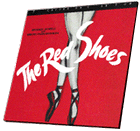Director:
Michael Powell and Emeric Pressburger
CAV: $124.95 -
3 discs, catalog # CC1401L
Before The Red Shoes, there were films with dance
numbers. After it, there was a new medium which combined dance,
design, and music in a dreamlike spectacle. Hollywood musicals were
quick to pay tribute -- An American in Paris was the most obviously
inspired -- and filmmakers from Minnelli to Scorsese have acknowledged
its influence. Like Diaghilev's legendary 'Rite of Spring', it marked
a triumph of artistic collaboration and has since become a benchmark
of modernity.
And yet The Red Shoes was considered a disaster by its
backers in 1948. The long ballet sequence which Powell and Pressburger
considered their finest achievement seemed sheer indulgence to
executives of the Rank Organisation. The film had gone over budget and
seemed to have no commercial potential. It was given a perfunctory
release in Britain, and its international fame only began after an
astonishing two-year unbroken run in New York.
Michael Powell and Emeric Pressburger, who called their unique
creative partnership The Archers, were no strangers to
controversy. Each film they made together in the five years before
The Red Shoes had aimed its barb at complacency and tackled a
new creative challenge. The Life and Death of Colonel Blimp
(1943) cheekily mocked the British establishment in the midst of war,
while revealing a subtle new Technicolor palette; A Matter of Life
and Death (1946) played outrageous tricks with time and took
colour experiments even further; and Black Narcissus (1947)
finally demonstrated their mastery of studio techniques to create a
dreamlike suspension of disbelief.
Looking for a new challenge amid the gloom of post-war Britain, The
Archers turned to an idea that Pressburger had first drafted in the
'30s, a film about the backstage life of a ballerina. Now they wanted
to develop this into nothing less than a manifesto for the claims of
art over mundane life. As Powell later reflected, 'For ten years we
had all been told to go out and die for freedom and democracy; but now
the war was over, The Red Shoes told us to go out and die for
art.' To a generation hungry for new peacetime ideals, the
neo-romantic world of total devotion to art was irresistible.
Through the eyes of a dancer -- unforgettably played by a rising
star of the Sadlers Wells Ballet, Moira Shearer -- and a young
composer, played by the versatile Marius Goring, we see and enter the
charmed circle of an international ballet company which embodies the
artistic legend of Diaghilev's Ballets Russes. And with one of
Diaghilev's own stars, Leonide Massine, and the leading dancer and
choreographer Robert Helpmann, the atmosphere is rich in authenticity.
At the centre of the company and the film is the most complex and
rivetting character The Archers ever created: the impressario Boris
Lermontov, played with malevolent, devastating charm by Anton
Walbrook. Lermontov lives through his creations. People and
relationships are ruthlessly subordinated to a drive which inevitably,
reminds us also of the passion to create films.
More than any other film, The Red Shoes deals with the
dangerous, magical process by which art is distilled from preparation
and effort. And, not content with creating and showing at full length
the 'Red Shoes' ballet which links all the characters' destinies, it
dares to take us into the inner world of fantasies which art can
unleash.
At a time when 'realism' was the fetish of so many filmmakers and
critics throughout the world, this was a bold gamble. It was the same
gamble that Eisenstein had taken in his operatic Ivan the
Terrible, that Ophuls would soon take in La Ronde (also
with Anton Walbrook), and that Kelly and Donen took in Singin' in
the Rain. None of these received their critical due when they
first appeared. But the passage of time has shown them to be among the
most powerful and evocative of all films. The Red Shoes
belongs in their company: a parable about the demands of art, as well
as a stunning demonstration of cinema's claim to have united the
traditional arts in a new synthesis.
Credits
Written, produced and directed by:
Michael Powell and Emeric Pressburger
Director of photography: Jack Cardiff
Production designed by: Hein Heckroth
Art director: Arthur Lawson
Editor: Reginald Mills
Music composed, arranged and conducted by: Brian Easdale
Featuring: The Royal Philharmonic Orchestra
The Ballet of The Red Shoes Choreography by: Robert Helpmann
The part of the Shoemaker created and danced by: Leonide Massine
Conducted by: Sir Thomas Beecham, Bart.
Transfer
The Criterion Collection is proud to present The Red Shoes in a
new digital transfer manufactured from a 35mm negative which was made
from the original Technicolor separations. This transfer also features
a digitally enhanced soundtrack. Transfer supervised by director of
photography, Jack Cardiff.
|


